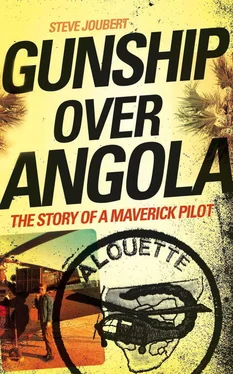The ‘Amsterdam incident’, or rather its aftermath, fundamentally changed something in me, although I was not consciously aware of the seismic shift at the time or for many years afterwards. When I look back now, I see that it blew away any ideals I still harboured that all my colleagues had my back in times of strife. At the same time, it led me to attach far greater value to the friendships built with the chaps upon whom I knew I could depend.
As is the case with most operational squadrons, 17 Squadron had a pool of pilots who formed the ‘inner sanctum’, with the rest on the periphery. I was undoubtedly part of the latter grouping, who were still useful but less likely to be given the peach assignments or unwavering support. This ‘placing’ even extended to one’s family.
For instance, once while I was away on a tour, my brand-new wife was invited to a tea party for the wives of the squadron’s pilots. She arrived and was greeted warmly by the hostess, but soon noticed that many wives were not present. She also picked up that the missing wives were exclusively those whose home language, like ours, was English. When Desiree asked the hostess where the missing wives might be, she was told by the giggling lady that she had ‘forgotten to invite the English wives’.
It seemed that the tea-party planner had erroneously deduced that Joubert was an Afrikaans surname and added Desiree’s name to the guest list.
*
During one of my tours to the Border, again based in Ondangwa, I was one of the gunship pilots in a two-ship formation that was tasked to provide close air support to an army reconnaissance operation taking place 25 kilometres into Angola just north of the Namacunde–Chiede road.
The other pilot was Neil McCall. We were to stand by at the old army base at Etale. As we climbed out of our aircraft after landing, we could hear the distant sound of mortars and rifle fire. We immediately got airborne and headed for the fight.
When we got to the scene, it was carnage.
It seems that an army patrol, based at Etale and mounted on horseback, had been ambushed by a large group of PLAN soldiers. This was unusual as, up to then, PLAN had been inclined to avoid contact with SADF forces, particularly when operating on Namibian soil.
There were some fatalities and a handful of our soldiers had been badly injured in the ambush, which ended as soon as the sounds of the approaching choppers could be heard by those on the ground. As was their usual practice, the PLAN soldiers bombshelled as soon as the attack was over.
Unfortunately for the PLAN guys that day, the site they’d chosen for the ambush lay in a large patch of dense bush, surrounded to the east, south and west by open salt pans. Only those who scarpered to the north, as most of them did, were assured of having overhead tree cover as they made good their escape.
Those who went south were easily tracked and dealt with in an operation that lasted most of the day. Neil McCall or me, or both of us, provided air support to the ground troops who swept through the area. As one of our pair of gunships would run low on fuel, the pilot would depart the scene and go to Etale to refuel, rearm and eat/drink before returning to relieve the other crew.
Finally, the action petered out and I returned to Etale. As I walked from my aircraft to the ops tent, I passed the main helipad, where the bodies of the dead PLAN soldiers had been placed. The bodies were being put into body bags for transportation by Puma to Oshakati, where I assumed they’d be identified, processed and afforded a dignified burial.
Just then, a youngish army major marched a group of around 30 young national servicemen or three-month campers (I never did find out which) up to the dead PLAN soldiers and began shouting insults at the bodies, his face contorted and angry, veins sticking prominently out of his sunburnt neck. My anger immediately rocketed off the charts, and when he made a move as if to kick one of them, something in me snapped.
During the months and years of lying, gin-depressed but still wide-awake into the small hours, in my mosquito-net-shielded cocoon, I had occasionally envisioned being shot down and killed inside enemy territory. This morbid image had evoked in me a hope, never voiced aloud to anyone, that if this ever happened, and I truly hoped it wouldn’t, that my body at least be treated with respect by those who gained custody of it.
I believed implicitly that such courtesy should work both ways, and in my sudden rage I saw this jumped-up tosser of a major, in attempting to impress his troops, violate the dignity of fallen military men. Before I could be stopped, or stop myself, I grabbed the major by the throat and pinned him up against a prefabricated concrete wall. I was so livid, so furious, that I was unable to speak, and just stared into his shocked eyes.
After a few seconds, some other chaps pinned my arms against my sides and I had to let him go and walk away. I think he ran after me and tried to take the issue further, but wiser heads intervened and prevented further confrontation.
I can’t remember any more of what subsequently happened, if anything, other than that I was extraordinarily tired afterwards.
A day or so later, the four-man reconnaissance group who had originally been standing by at Etale to help, were themselves attacked while hiding out in the heat of the day in a patch of bush situated in the middle of a shona 30 kilometres into Angola.
Neil and I scrambled to help them and we arrived over their position 20 minutes later.
Of the original four in the recce group, only two white officers remained. The other two, being Ovambo tribesmen and able to melt into the local landscape, had already managed to make good their escape by the time we arrived.
Both men had been wounded, and even though we were in gunships in the sky above them, they were still taking heavy fire from the FAPLA troops who’d found them. The FAPLA contingent had dug into secure cover immediately west of the two recces, and we were unable to see their positions in the heavy bush. Nevertheless, we laid down covering fire, hoping to keep them from advancing on our guys.
Neil suggested to me that I descend, land and pick up one of the guys on the ground while he gave me covering fire. When I had done so and was again airborne, I could provide cover for him to pick up the remaining recce and then we could get out of there. He also suggested that I jettison my 20 mm cannon if I found that my gunship was too heavy to take off with the additional weight of a passenger. I realised that this would leave him extremely vulnerable to enemy fire when he went in, but he told me that it was a chance he was willing to take.
After planning my approach to the LZ, and just as I was starting my descent, the radio crackled into life. A formation of two Pumas with medical personnel aboard reported that they were just a few minutes out, and that our two gunships were to remain on station and make certain that enemy fire was suppressed while they extracted the wounded recces.
The extraction proceeded without further incident.
Two days after that, our two gunships were called out to an army base called Elundu to provide air support to an imminent punch-up between a small stick (four to six men) of PLAN soldiers and some SADF infantry based at Elundu, who were following their tracks ever more closely.
We were soon to discover that the main body of the 120-strong group of PLAN fighters, which had ambushed the mounted army patrol near Etale just days earlier, had regrouped and were intent on creating havoc in Ovamboland by taking on the SADF directly. This level of aggression was unheard of and, as such, totally unexpected.
The main PLAN body, using local informants to establish the whereabouts of a 20-strong army patrol, were lying in wait in an ambush position on a small road about eight kilometres east of the Elundu base. They had earlier sent out a stick of four soldiers to walk ahead of the army patrol and lure them into the ambush.
Читать дальше












